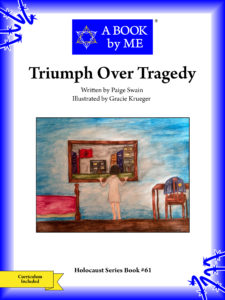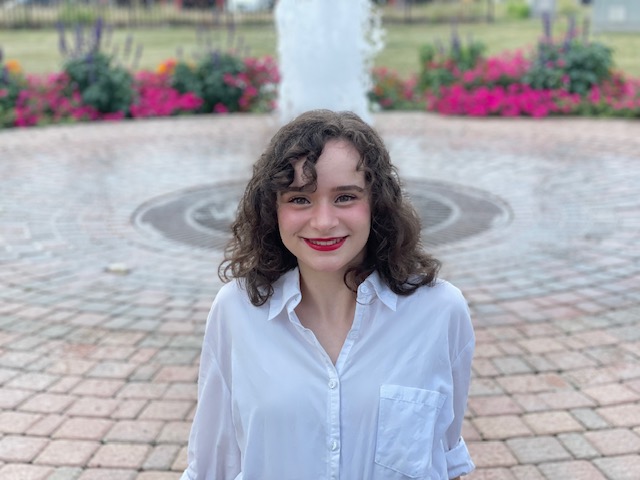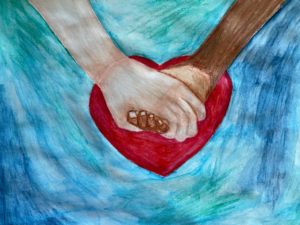Triumph Over Tragedy
Dr. Irene Butler - Jewish Holocaust Survivor
Written by Paige Swain and Illustrated by Gracie Krueger
For the series A BOOK by ME - True Stories Written by Kids for Kids
 A young lady named Paige Swain lives in the rural community of Geneseo (IL). She was interested in writing a storybook in the height of the pandemic which I told her was possible with a Zoom meeting. She began looking for a Jewish Holocaust survivor story and came upon the story of Irene Butter. Irene was a child in Germany when her parents decided it was safer to move their family to Amsterdam. Irene lived in the same neighborhood as Anne Frank who was two years older. A few years later all the Jewish families there realized they had not moved far enough away when the Nazis invaded.
A young lady named Paige Swain lives in the rural community of Geneseo (IL). She was interested in writing a storybook in the height of the pandemic which I told her was possible with a Zoom meeting. She began looking for a Jewish Holocaust survivor story and came upon the story of Irene Butter. Irene was a child in Germany when her parents decided it was safer to move their family to Amsterdam. Irene lived in the same neighborhood as Anne Frank who was two years older. A few years later all the Jewish families there realized they had not moved far enough away when the Nazis invaded.
Irene and her family were sent to two different concentration camps. In Bergen-Belsen, Irene’s best friend was Hanneli Goslar, also from Amsterdam. Hanneli learned that her friends Anne and Margot Frank were in the same camp and both she and her sister were sick so she collected clothing to throw over the fence to them. Irene went with her and they did their part but the Frank sisters never received it since another woman stole their package.
This story teaches Dr. Irene Butter’s story well and makes the Anne Frank diary more real to young readers. Paige and her young illustrator named Gracie Krueger of Davenport (IA) had a great experience telling her story. When her book was published, Paige and Gracie were greeted by members of the community at a book signing in Geneseo. It’s wonderful to see our students impacting their communities.
Deb Bowen
A BOOK by ME
Dr. Irene Butler
Jewish Holocaust Survivor
Triumph over tragedy. Dr. Irene Butler absolutely did that. The tragedy – the Holocaust, the genocide of European Jews during World War II. The Triumph – the life and legacy Dr. Butler built when she began anew in America.

Irene first grade Berlin 6 yrs old
The changes and challenges Irene Hasenberg, or ‘Reni’ as she was called, experienced from the time she was six and living comfortably in Berlin, Germany are unthinkable for most of us. Millions didn’t survive. But Dr. Butler did, through pure will and grit (and a little luck, she said).
Reni, born to John and Gertrude Hasenberg in 1930, was very close to her father, a well respected man in the community who ran their family bank business until the Nazi’s overtook it. He then sought work elsewhere and had to leave the family for a short time. John fought for Germany during World War I, and his family had lived in Germany for generations, so leaving Germany – and his family – was a very difficult decision.
Reni’s early memories include moving from Berlin to Amsterdam in 1937 with her brother Werner and her mother. Amsterdam was where her father had been working, so they thought they would be free from the ever-expanding Nazi threat. Reni’s grandparents were eventually forced to Theresienstadt concentration camp and were never heard of again.
Amsterdam was a temporary home, however, and on June 20, 1943 Reni and her family were moved to Westerbork transit camp in Holland, which was a stopover camp for Dutch Jews being sent to extermination camps. They had applied for Ecuadorian passports which would have allowed them to be traded in a prisoner exchange program. But, the passports had not arrived in time.
Dr. Butler has vivid memories of the terrifying Westerbork camp. There was no standard for hygiene, and lice was the main reason for illness and death. One of the most horrific memories was the cattle cars that would come to take people away – never to be seen again. She remembers this weekly ritual as a “symbol of horror and death.”
In February, 1944, the family of four was placed on a train to Camp Bergen-Belsen. Dr. Butler remembers this as a “slow death camp” because of the inhumane conditions – slave labor, minimal food rations and lice. There were no gas chambers but many people got sick from the conditions and died. Dr. Butler’s family got very sick at this camp, especially her father.
Also, at the camp was a familiar figure – Anne Frank. Dr. Butler recalls how she met Anne through her friend, Hanneli Goslar, and how they collected clothing for Anne and her sister, who were very sick. Unfortunately, the clothing never made it to Anne because a woman stole the clothing before Anne could retrieve it. The girls were going to visit the following night. However, news came that Reni’s family would be exchanged the next day, so she did not see Anne again.
Freedom wasn’t free for the Hasenberg family. Reni’s father was beaten terribly prior to leaving Bergen-Belsen and died two days after leaving the camp. His body was left at the train station in Biberach, Germany.
Reni’s mother and brother were sent to a hospital in Switzerland because they were very ill, and Reni was sent on to Algeria, to a refugee camp, Camp Jeanne d’Arc, to start her recovery. Reni stayed in Algeria – healing physically and, to some extent, emotionally. In 1945 she boarded an American Liberty ship bound for the United States. She arrived in Baltimore on Christmas Eve and was reunited with her mother and brother six months later when they arrived in the U.S.
At just 15 years old when arriving in the States, Reni was told never to talk about what she had experienced. The rest of the world was not ready to hear about those atrocities. And, it was overwhelming to build a new life, so Reni put the past in the past. She focused on finishing high school, graduating from Queens College in New York City, and then becoming the first woman to earn a Ph.D. in Economics from Duke University. Reni had started building her legacy.

Irene Butter
For over four decades Reni stayed silent. In 1987 that changed. Dr. Butler was invited to speak at an Anne Frank exhibition in Detroit. Realizing Anne would never be able to tell her story, Dr. Butler needed to tell hers. She had also remembered Elie Wiesel talking to survivors, stating, “If you smelled the air and heard the silence of the dead, it is your responsibility to tell your story, or else the victims will die twice.” Dr. Butler understood she had a responsibility to share her story.
From that point forward, Dr. Butler has been educating others, especially young adults, about the importance of action and activism, and to “never be a bystander.” She believes “students must develop a social conscience” and “this is really a time of great relevance. We can overcome things if we don’t act as victims.”
A lot of memories are surfacing now for Irene due to what the world is experiencing. With the rise of authoritarianism and the separation of children and families at the border, the trauma comes back. It is difficult for Dr. Butler to see this when she remembers being separated from her family. “Young people have no idea what it feels like” with regards to the hardships of the Holocaust, and Dr. Butler wishes we could teach history so people could understand ethnic cleansing and think about how to prevent it.
Dr. Butler has led a very active life by never being a bystander. She believes we all have a responsibility to preserve democracy, and we need to “emphasize action.” We could build a better tomorrow by refusing to be enemies, which is also the name of a documentary featuring Dr. Butler.
Dr. Butler has received numerous awards and achievements and has invested countless hours in making our world more socially conscious, especially for our younger generation. In 1990 she co-founded the Raoul Wallenberg Medal & Lecture at the University of Michigan, which provides humanitarian role models for students and the community in honor of Raoul Wallenberg. The motto of this project is, “One Person Can Make A Difference In Building A Better World.” In 2002, Dr. Butler co-founded Zeitouna (meaning olive tree in Arabic), an Arab-Jewish women’s dialogue group based in Ann Arbor, Michigan, dedicated to working toward a just peace.
Dr. Butler advocates taking action to bring about change. Some things we can do to “never be a bystander” is to commit to volunteering four hours a month – choose your passion! Stand up for others who may not have a voice and eradicate bullying. Promote social justice. Share Dr. Butler’s story.
Triumph Over Tragedy is Dr. Butler’s story of how she persevered when all odds were against her. She shares her story to remind others we all have the ability to create change in this world – our world. This can happen regardless of our past. Dr. Butler’s inspirational journey has led many to speak out about social injustice. Educating our youth on this topic is fundamental in keeping the momentum going.

Author Paige Swain

Illustrator Gracie Krueger





